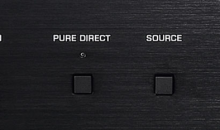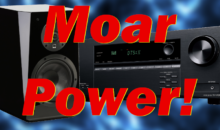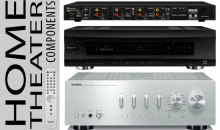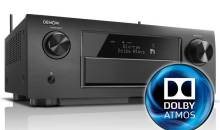How to Fix AV Receivers and Start a Revolution
I don’t get paid enough to fix AV receivers for every manufacturer and solve their declining sales problems. I wanted, however, to deliver a “free tip” for product and sales managers who are spinning their wheels at the profound reduction in interest in AV receivers that seems to be sweeping the nation. Sound bars? Flying off shelves. Home theater systems in a box? Doing just fine. Desktop radios and headphones? Literally breaking sales records left and right.
So what’s wrong with the AV receiver? In nutshell—it’s too darn complicated, and they offer far more than what the average consumer needs. We need to fix AV receivers to simplify them and make them easier to use. Let me elaborate on this a bit.
Features, Features, Features
While I love features, the AV receiver has become much too complicated. And features mean nothing if you can’t easily make everything work together flawlessly. While I like being able to receive input from every conceivable source component in my home theater, most people simply want to “Watch TV”, “Play a Blu-ray”, “Listen to Music” or “Play a Video Game”.
Really that’s pretty much it. But AV receivers don’t think that way (actually they don’t do much thinking at all). They are set up like a central hub and you must practically tell them everything about your system before they can do much of anything. An AV receiver doesn’t know when a Blu-ray Disc player has been connected—not until you tell it. And this, despite the fact that the infrastructure exists to communicate that information over the very HDMI connection that joins the two products. Fixing AV receivers has to start with making them smarter.
Check out our Setting Up an AV Receiver article for an example of the myriad of steps required to make everything work properly.
It shouldn’t be this hard. It doesn’t need to be.
If you boil down the experience to what the user really wants to do, then the AV receiver becomes a helpful instrument—rather than a device that can be all things to all people. And it’s not the features that are the problem so much as the interface. Which brings us to our next point.
Why Isn’t It as Easy to Use as My iPhone?
Connecting devices to your AV receiver should be as simply as running a single HDMI cable. After that you shouldn’t have to do anything. The new device should show up on your on-screen menu and the rest of the system should adjust to compensate for the new device as well.
This is the way AV receivers SHOULD work. But they don’t. Fixing these surround receivers should make them easier to control and configure.
Additional functions for your AV receiver, like accessing streaming services or configuring your room EQ, should be as simple as downloading an app. You shouldn’t have to know anything about your system or drive down 4 levels deep into a Setup menu to change the way your system works. Nothing else works this way, but for some reason the AV receiver gets away with added complexity that simply isn’t needed—or used by most consumers.
Quality or Capability?
Another thing that is pushing the consumer away from the AV receiver is the decided turn towards feature-bloat. There is something to be said for the amount of features increasingly found in receivers these days—and how much less they weigh. I’ve seen AV receivers that claim to be mi-level offerings and they weight less than 12 pounds. There are Blu-ray players that weigh more than that!
So receivers are adding more and more features (many of which consumers don’t need or use) and they are reducing the quality of components. What can be done? A lot.
How to Save AV Receivers and Spark a Revolution
In my opinion, any manufacturer could take control of the market in one fell swoop. All they would need to do is address the issue of what consumers really need—and how to cater to the fact that no one likes reading user manuals. The capabilities of an iPhone are amazing, but there’s simply no one I’ve ever met who’s read the user manual.
I’m not even sure there is one.
The AV receiver could be revolutionized if manufacturers made the following changes. And mark my words, the result would be massive consumer adoption unlike anything they’d ever seen:
- Eliminate all Analogue Video Inputs, Leaving Only HDMI
This new product would be revolutionary and it’s OK to force consumers to upgrade components or simply cater to the ones who have modern electronics. By eliminating analogue video, you also eliminate the complexity of having to tell the receiver what’s plugged in, and where to access it. This ties into my next point.
- Digital and Analogue Audio and DACs
New receivers should provide analogue and digital audio sources with dedicated DACs to convert all those inputs to usable Zone 2 line and speaker level outputs. In this way, and connected source device should be able to send audio to a second or third zone without having to have a separate analogue audio line connected.
- Use HDMI CEC to Tell the Receiver What’s Been Connected
I don’t care if this involves paying money to every manufacturer on the planet to gather the required information (or buying all of their products to text them). When an Oppo Blu-ray player is connected to the receiver, the receiver should KNOW that an Oppo Blu-ray player has just been connected. The GUI interface and all activity-based functions should update accordingly. For analogue and digital audio sources, once a connection has been detected, the on-screen interface should simply ask you what it is, allowing you to preview the source and label it with an appropriate icon (iPod, iPhone, tuner, streaming media server, etc).
- Activity-based Functions Are Mandatory
Consumers don’t need an interactive GUI for menu functions, allowing them to set up speakers, choose DSP modes, set amplifier assignments and configure inputs—they need activity-based controls.People want to watch TV, listen to Internet music, play a Blu-ray, or use a game console. They don’t care about anything else—and so setup and configuration should be automatic. The system should be able to analyze what equipment is connected and do the rest. All you should need to do is tell it what you want to do.
- Automatic Speaker Setups Should Actually Set Up Your Speakers
Most automatic speaker setup systems don’t correctly set crossovers or speaker size. They really need to be better equipped to do so. Room EQ is so hit or miss that, in my opinion, it’s a failed experiment. You have to have a PhD in acoustics to get these systems to sound better than “Off” and it rarely works the first time without a lot of tweaking. To me, that indicates that it should be removed from the AV receiver platform altogether and relegated to a separate “black box” solution for custom installers and tweakers. An automatic speaker setup system should not be located in the menu at all, since it only gets run once. It should be an automatic function that appears any time a microphone is connected to the front mic jack of a so-equipped AV receiver. This isn’t rocket science, it’s basic user-interface 101. But to-date, no receiver manufacturer has picked this up.
- Universal Remote Control Interface
The next generation AV receivers should come with a basic remote, but the real power should come from an app-enabled piece of software that is entirely activity-based and which can control all components in the system. It should necessarily be tied to every known fiber, cable and satellite provider in the industry and should allow you to not only tell it what you want to do, but allow you to select what shows you want to watch by genre, title, channel or schedule. The interface should be very easy to browse and geared towards pushing content at you to allow you to select what you want to watch and/or record. It should be intuitive, clean and comprehensive.
- Scalable Power, Not Features
If AV receiver manufacturers re-architected their systems to work in the ways described above, the step charts could simply offer two differences between models: number of inputs and power output. It makes sense. You can offer a low, medium, and high offering that would be perfect for the entry-level user, mass-market, or the power user who really wants to blow everything up to epic proportions. The advantage, of course, is that the interface, being largely software, won’t need to change much from system to system, so the ability to up-sell and generate new models comes from the ability to provide a higher level of quality for the amplifiers and source capabilities.
Conclusion
I can’t tell manufacturers what to do…Well, yes I can. I just can’t make them listen. If a manufacturer does take these things into account, however, the result will be instant industry domination. No one will want to use a traditional AV receiver and the AV world will finally have moved into the 21st century. The real question is, are Yamaha, Denon, Marantz, Harman Kardon, Onkyo and others going to get beat out the way the music labels got beat out by the iPod? Or will they rise to the occasion, forget what they know, and create the future of AV entertainment.
Our guess is that the solution will once again come from Apple Computer. The rest of these companies are so entrenched it’s hard to imagine them seeing the future and being equipped to bring it into the living room soon enough. They’ve had ample opportunity and we’ve seen the same cycles over and over that lead us to believe they simply don’t have the vision to pull it off.
But when that new product comes out…I will be the first in line. And I’ll make sure all my friends jump on the train with me.







Things that make me go hmmmmmmm.
Wow! It’s so refreshing to see that I am not the only one who hates being force fed a boatload of useless inputs and “features” just to get the power output I need. Just had a month old Yamaha RX A 2040 inexplicably die on me, meanwhile my 8 year old Onkyo TX SR 805 is still going strong, save the front panel going out about a year ago which is fairly common for the Onkyo’s I’ve learned. Even without a working front panel display, I think I’m going to stick with the Onkyo until something truly revolutionary comes along.
Thanks for a terrific article. Someone needed to say it.
A Pioneer AV Receiver I purchased through Amazon a little over a year ago has sound but no video. The receiver in question is the Pioneer VSX 330 4K Home Cinema Receiver. I contacted Amazon but received no reply. I have contacted Pioneer support twice, also, no response. The receiver was purchased on the 6th of October 2016 and stopped working on the 13th of November this year. Having paid £200.00 for the receiver I can’t afford to bin it and need to find a reputable shop to carry out the necessary repair. I have been in the country only a short while and I don’t know who to approach for the repair. Do you perhaps have any suggestions? as any assistance in resolving my issue will be most appreciated. I reside in Heartsease, Norwich.
Kindest regards,
Brian